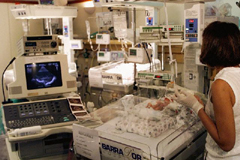
Technology and Caring
Overview
 Technological proficiency in nurses is a desirable attribute to function optimally in our changing health care system: not as a substitute for nurses' care, but as an actual enhancement of care (Locsin, 1995). The competent use of machine technology is becoming integral to nurses' work, in acute and community settings. Nurses need to develop technological know-how to keep pace with the rapid development of new health technologies. Technological proficiency in nurses is a desirable attribute to function optimally in our changing health care system: not as a substitute for nurses' care, but as an actual enhancement of care (Locsin, 1995). The competent use of machine technology is becoming integral to nurses' work, in acute and community settings. Nurses need to develop technological know-how to keep pace with the rapid development of new health technologies.
Understanding technology as a humane way to know a client more fully, as a person, is the expression of effective integration of machine/computer technology and a nurse's personal care. Technological competence requires intentionality, along with compassion, confidence, commitment, and conscience (Roach, 1987). The Canadian Nurses' Association initiated a Strategic Plan on Health Care Technology to give guidance and support to nurses in dealing with challenges in using technology in health care (Caloren & Salois-Swallow, 1994). One goal of this strategic plan is to ",...promote the importance of nursing practice standards to provide client/family centered care in the health care technology context" (p. 44).
 The relationship between computer literacy, technological competence and a nurse's ability to care is congruent for quality care. Computer literacy represents a proactive response to technology which enhances caring in nursing (Delaney, 1990). As well, the ability to apply critical thinking, expert clinical decision-making, and sound clinical judgment are mandatory in today's "high-tech" health arena. As computers and other technologies gain prominence both within health care institutions, and clients' homes as in telenursing, nurses need to find ways to convey their caring despite the gadgetry. The relationship between computer literacy, technological competence and a nurse's ability to care is congruent for quality care. Computer literacy represents a proactive response to technology which enhances caring in nursing (Delaney, 1990). As well, the ability to apply critical thinking, expert clinical decision-making, and sound clinical judgment are mandatory in today's "high-tech" health arena. As computers and other technologies gain prominence both within health care institutions, and clients' homes as in telenursing, nurses need to find ways to convey their caring despite the gadgetry.
Ends in View
This learning activity is intended to give the learner the opportunity to:
1. Develop awareness of the potential effects of technology including computers on clients.
2. Reflect on their own ability to work with technology and computers in the clinical area while
maintaining a personalized caring way of being with clients.
3. Recognize how to care for clients, using technology in a holistic way.
In Preparation
1. READ: Imanoff, J. (January, 2020). Rising to the case: Caring in the age of technology. Canadian Nurse.
2.Read: Johnson, J. (2015). Editorial: Tasks and Technology Versus Compassion and Caring in Nursing: Are they Mutually Exclusive? Journal for Nurses in Professional Development, 31 (6), 338 - 340.
3. READ: Locsin, R. (1999). Development of an instrument to measure technological caring in nursing. Holistic Nursing Practice, 1 (1), 27 – 34.
4. READ: WGU. (2019). 7 nursing technologies transforming patient care. Nursing and Healthcare Blog.
In Practice
1. Within the clinical setting, notice the various types of technology and computers used by
nurses and other health care professionals. If you can, notice how the clients react to the
technology. Does it aid or impede client care? What level of technological competency is
needed by the nurse to ensure that the client gets the attention they need?
2. Visualize the process of telenursing and telehealth. List the pros and cons of providing
client care from a distance using technology to connect to your clients.
a) What is facilitated?
b) What is impeded?
c) What is missing?
d) Is anything added that is not available in routine health care in an agency or clinic?
3. Reflect on how you (or nurses you see) demonstrate caring for your client as you learn to
use/competently use the following common technologies:
a) Electronic thermometer
b) Glucometer
c) IV Pump
d) PCA Pump
e) Holter Monitor
f) EEG monitor
g) Computerized Medication System
h) Computerized Charting
4. Recalling the slides you viewed in Preparation assignment #1 (Patient Information Manager)
list the behaviors and competencies you would need to use such a system and still show
quality caring for your client. Why is computer literacy an important part of caring and technology?
In Reflection
1. Reflect on how you can cultivate caring and technological competence in your practice.
2. How do the BCCNM Standards of Nursing Practice guide you in your use of technology
coupled with caring behaviors and presence?
3. Will you be able to give quality care in the future if you do not develop technological competence?
References
Caloren, H. & Salois-Swallow, D. (1994). Strategic Plan on Health Care Technology. In Grobe, S. & Pluyter-Wenting. (Eds).
Nursing Informatics: An international overview for nurses in a technological era.St. Louis: Mosby, 42 - 45.
Delaney, C. (1990). Computer technology: Endangering the essence of nursing? In J. Comi-McClosky & Kennedy-Grace,
H. Current issues in nursing, St. Louis: Mosby, 601 - 606.
Grigsby, J. & Sanders, J. (1998). Telemedicine: Where It Is and Where It's Going.
Annals of Internal Medicine, 129, July 15, 123-127. Online:
http://www.acponline.org/journals/annals/15jul98/telemed.htm
Health Probe Patient Information Manager, Online:
http://www.healthprobe.com/
Locsin, R. (1995). Machine technologies and caring in nursing. Image: Journal of Nursing Scholarship, 27 (3), Fall, 201 - 204.
Roach, S. (1987). The human act of caring. Ottawa: Canadian Hospital Association.
NEXT: Health Information: Nursing Components and EHRs.... . .
|